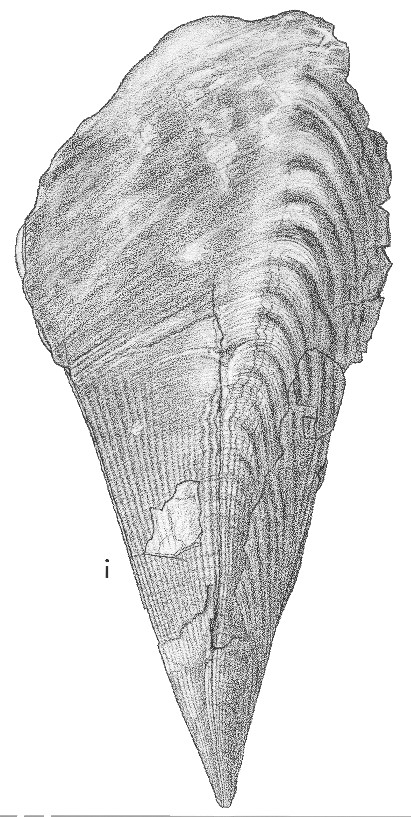
Revised descriptions of New Zealand Cenozoic Mollusca from Beu and Maxwell (1990)

 | Revised descriptions of New Zealand Cenozoic Mollusca from Beu and Maxwell (1990) | 
|
  (Pl. 16i): Awamoa Creek, Oamaru, Altonian (TM2828, GNS; figured by Murdoch 1924, pl. 9, fig. 2) (x 0.67). |
Beu & Maxwell (1990): Chapter 11; p. 178; pl. 16 i.
Synonymy: Pinna distans Hutton 1873b, p. 126; "Pinna lata Hutton" of Murdoch 1924, p. 157 (not of Hutton 1873b)
Classification: Pinnidae
Description: Moderately large for genus (height c.300 mm), narrowly triangular (apical angle about 35°), of rhomboidal section medially (with a low median radial ridge from umbo to mid-valve), flattened distally. Outer layer prismatic calcite, up to 5 mm thick; inner layer nacreous aragonite. Radial sculpture of about 20 narrow costae with considerably wider interspaces over proximal half of shell, obsolete over ventral third. Commarginal sculpture on proximal half of narrow, well spaced ridges intersecting radial costae; remainder of shell with fine growth lines dorsally, very prominent rounded folds ventrally. Interior (visible in very few specimens) with very deeply subdivided nacreous layer, the long, narrow embayment of pallial line producing a weakened shell area (and consequently a radial crack near umbo of most specimens) coincident with exterior median ridge.
Comparison: Murdoch (1924, p. 157) referred the figured specimen to Pinna lata, which is based on a specimen from "Cobden" near Greymouth, probably of Whaingaroan age. The type specimen is lost but Hutton's exceedingly brief description is of a broadly triangular shell (apical angle 60°) with sculpture of commarginal striae. A probable near-topotype from Point Elizabeth in the GNS collection is broadly triangular (axe-head-shaped) and has weak radial sculpture as well as growth lines; it does not resemble the Awamoa specimen. The latter is much closer in shape to P. distans, which was described from "Caversham" (near Dunedin), and is therefore probably of Otaian or Altonian age. The holotype, however, is a steinkern with fewer (c. 11), much stronger and more widely spaced radial costae than the Awamoa shell, so the latter can only be tentatively assigned to P. distans. Pinna has a sporadic record in New Zealand from at least Piripauan (Late Cretaceous) to Altonian, and was present during Triassic and Jurassic time, but most of the available material is poorly preserved, and species-level taxonomy is consequently unsatisfactory. Rosewater (1961, p. 218) claimed that P. distans and P. lata are "part of Atrina pectinata zealandica Gray" (the modern "horse mussel"), but A. zealandica is not known older than Tongaporutuan, and all earlier records appear to be of Pinna (sensu stricto). All Eocene to Early Miocene material we have seen shows at least some sign of the median external ridge and umbonal crack characteristic of Pinna, and some unusually well preserved specimens (e.g., from Duntroonian-Waitakian limestone at Curiosity Shop, Rakaia River) clearly reveal the bilobed internal nacreous area of Pinna.
Hutton (1873b, p. 26) described a third "species" of Pinna, P. plicata, questionably from Culverden, North Canterbury. This was shown by J.A. Thomson (in Suter 1915, p. 53) to be a fragment of the trace fossil Zoophycus, probably produced by a polychaete worm.
Distribution: Duntroonian(?)-Altonian; Altonian, Mount Harris Formation, Awamoa Creek, Oamaru, not uncommon (at least locally) but difficult to collect.
Cite this publication as: "A.G. Beu and J.I. Raine (2009). Revised
descriptions of New Zealand Cenozoic Mollusca from Beu and Maxwell (1990). GNS
Science miscellaneous series no. 27."
© GNS Science, 2009
ISBN
978-0-478-19705-1
ISSN 1177-2441
(Included with a PDF facsimile file
copy of New Zealand Geological Survey Paleontological Bulletin 58 in CD version
from: Publications Officer, GNS Science, P.O. Box 30368 Lower Hutt, New
Zealand)